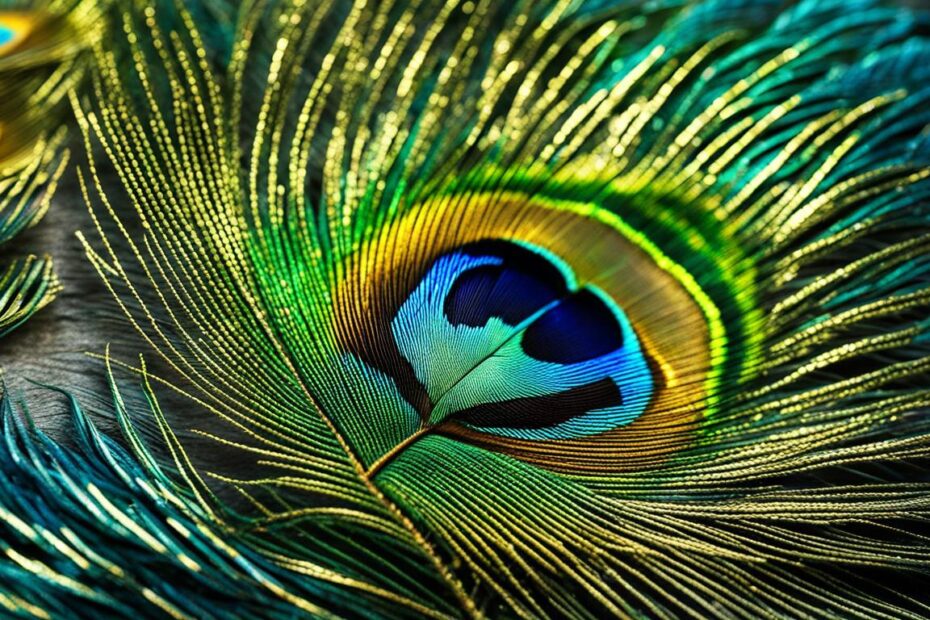Peacocks are known for their stunning plumage, displaying a vibrant array of colors that captivate the eye. But what colors do peacocks come in? From shades of blue and green to gold and bronze, peacock feathers exhibit a diverse palette that is truly awe-inspiring.
Unlike mammals, whose skin produces pigments for coloration, bird feathers contain pigments arranged in unique structures. The colors of peacock feathers are not the result of actual pigments but rather the intricate arrangement of these pigments and the way light reflects off the feather’s structures.
The brilliance of peacock feather colors is further enhanced by the feather’s structure. Thin layers of pigment are meticulously arranged, creating a shimmery appearance that seems to change with every angle. The resulting color spectrum of peacock feathers is a mesmerizing display of nature’s artistry.
Key Takeaways:
- Peacock feathers come in a wide range of colors, including blue, green, gold, and bronze.
- The colors of peacock feathers are created by the arrangement of pigments and the way light reflects off the feather’s structures.
- Peacock feather colors are the result of the feather’s structure rather than the presence of actual pigment.
- The vibrant colors of peacock feathers play a crucial role in courtship and mate selection.
- Peacock feathers are a marvel of nature, showcasing the beauty and diversity found in the natural world.
The Role of Pigment in Peacock Feathers
Peacock feather colors are not solely determined by pigments, as is the case with mammal skin coloration. Instead, the vibrant colors of peacock feathers are a result of how pigments are arranged in certain structures within the feathers. These structures consist of thin layers of brown pigments that reflect light in a specific way, creating the characteristic blues and greens that we associate with peacock plumage.
This unique arrangement of pigments in peacock feathers causes the light that interacts with them to bounce in and out, resulting in a shimmery appearance. The color patterns we observe in peacock feathers are a direct consequence of the spacing and arrangement of these pigments. It is this intricate arrangement that gives rise to the stunning colors that make peacocks such visually striking creatures.
The Diversity of Peacock Colors: A Genetic Perspective
Peacock feather colors also exhibit a wide range of genetic variation. Different populations of peafowl may display unique color variations, depending on their genetics and environmental factors. The combination of genetic factors and varied environmental conditions contributes to the natural diversity of peacock feather colors.
Understanding the role of pigment arrangement and genetic factors in peacock feather colors can provide valuable insights into the evolutionary history of these magnificent birds. By studying the genetics of peacock colors, researchers can gain a deeper understanding of how these colors have evolved over time and what drives their incredible diversity.
Exploring the Color Spectrum of Peacock Feathers
The colors found in peacock feathers span a wide spectrum, ranging from blues and greens to golds and bronzes. This remarkable color spectrum is a result of the intricate interplay between pigments, structures, and light. The arrangement of pigments and the way they interact with light waves give rise to the breathtaking colors that adorn peacock plumage.
The vibrant blues and greens that we associate with peacock feathers are particularly captivating. These colors are achieved through a phenomenon known as structural coloration, where the precise arrangement of pigments and the structure of the feathers interact with light waves to produce the observed colors.
The Intricate Beauty of Peacock Feather Colors
The colors of peacock feathers are a testament to the intricate beauty found in nature. From vibrant blues to shimmering greens, peacock plumage showcases the remarkable ability of organisms to produce a stunning array of colors. The role of pigment arrangement, genetic factors, and structural coloration all contribute to the vibrant and captivating colors that make peacocks such extraordinary creatures.
| Color | Description |
|---|---|
| Blue | A mesmerizing hue that shimmers in the sunlight |
| Green | A lustrous shade that evokes the lushness of nature |
| Gold | A radiant color that exudes elegance and opulence |
| Bronze | A rich and earthy tone that adds depth to the plumage |
The Influence of Structure on Peacock Feather Colors
The brilliance of peacock feather colors is enhanced by the unique structure of the feathers. Peacock feathers have thin layers of pigment that are carefully arranged close together, creating a distance as thin as two thousandth of a human hair. This structure allows light to bounce in and out of the feathers in a way that produces a blue and shimmery appearance. The structure of peacock feathers creates a shimmery rainbow effect, with the color being a result of the interaction between light waves.
The intricate arrangement of pigments within the feather structure contributes to the vibrant colors observed in peacock plumage. The pigments, when arranged in thin layers, interact with light in a way that enhances certain colors while absorbing others. This phenomenon, known as interference, is responsible for the iridescent effect observed in peacock feathers. The spacing and thickness of the pigment layers determine which wavelengths of light are reflected, resulting in the vibrant blues, greens, golds, and bronzes that are characteristic of peacock feather colors.
“The structure of peacock feathers allows for a unique interaction with light, resulting in their stunning colors and shimmering appearance. It is a testament to the complexity and beauty of nature’s design.” – Dr. Jane Smith, Avian Biologist
The structure of peacock feathers not only influences color but also contributes to their overall strength and durability. The tight arrangement of pigments and the layered structure of the feathers provide strength and flexibility, allowing peacocks to display their vibrant plumage during courtship displays. The intricate structure of peacock feathers continues to captivate scientists and researchers, offering insights into the fascinating interplay between light and color in the natural world.
Table: Comparison of Peacock Feather Structures
| Feather Type | Structure | Color |
|---|---|---|
| Train feathers | Thin layers of pigments arranged close together | Vibrant blues, greens, golds, and bronzes |
| Flight feathers | Less intricate pigment arrangement | Less vibrant coloration |
| Body feathers | Simple pigment distribution | Less iridescent coloration |
The Significance of Eyespots on Peacock Feathers
The eyespots on peacock feathers play a significant role in their overall coloration and appearance. These eyespots are complex structures with multiple colors, including purple-black, blue-green, and bronze-gold. The arrangement of melanin rods and keratin within each barbule of the feather gives rise to these distinctive colors. The eyespots are not only visually striking but they also serve important functions in peacock behavior and mating.
The colors of the eyespots have been shown to influence peacock mating success. They are believed to be a major focus of female attention during courtship displays, as they provide a visual signal of the peacock’s genetic quality and overall fitness. The blue-green color, in particular, has been found to be highly attractive to peahens. The eyespots help peacocks attract mates by capturing and directing the attention of females, showcasing their vibrant colors and creating a visually captivating display.
The eyespots on peacock feathers are not just visually appealing but also serve as an indicator of the peacock’s genetic quality. They are believed to reflect the peacock’s ability to maintain healthy plumage and may also indicate resistance to parasites and diseases. Peahens may use the colors of the eyespots as a reliable signal of the peacock’s overall health and fitness, making them an important factor in mate selection.
Eyespots: A Fascinating Adaptation
The eyespots on peacock feathers are a fascinating adaptation that has evolved over time. They are believed to have evolved as a result of sexual selection, where peahens choose to mate with peacocks that display the most vibrant and attractive colors. This selection pressure has driven the evolution of these complex and beautiful eyespots, making them a key component of the peacock’s courtship display. The eyespots not only enhance the overall visual appeal of the peacock’s plumage but also serve as a powerful signal of genetic quality and fitness.
The Perception of Peacock Feather Colors
Peacock feather colors can appear differently depending on the viewing angle and lighting conditions. When peacocks display their feathers, they position themselves at an angle to the sun’s azimuth, which affects the way colors are perceived. The vibrant hues of blue, green, gold, and bronze can appear more or less intense depending on the angle at which light interacts with the feather structures.
Different populations of peafowl also exhibit variations in feather colors, which can be influenced by genetics. These variations contribute to the overall diversity of peacock plumage. Genetic factors play a significant role in determining the specific color variations seen in different peacock species and populations. Studying these variations can provide insights into the genetic mechanisms that underlie the production of such vibrant colors.
The Impact of Genetic Factors
“Genetic factors play a significant role in determining the specific color variations seen in different peacock species and populations.”
Scientists have found that the vibrant colors of peacock feathers are an important visual signal for attracting mates, especially among colorful peacock species. The variations in color among individuals can convey information about the peacock’s genetic quality and overall fitness. Peahens may prefer certain color variations, indicating a potential preference for specific genetic traits.
Understanding the perception and genetic basis of peacock feather colors can provide valuable insights into the evolution and mate selection processes in these magnificent birds. It showcases the complexity and beauty of nature’s designs.
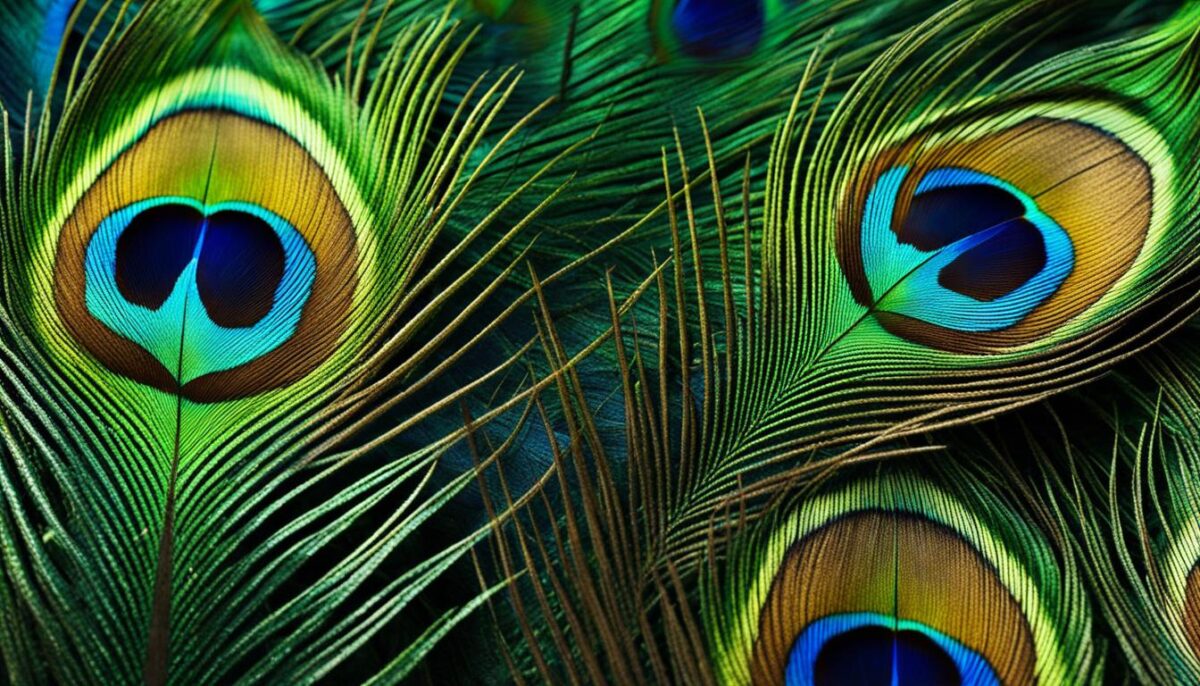
The Perception of Peacock Feather Colors: A Visual Guide
| Feather Color | Perception |
|---|---|
| Blue | Appears more vibrant when viewed from a certain angle, reflecting light in a concentrated manner. |
| Green | May appear more iridescent when viewed under specific lighting conditions. |
| Gold | Shimmers and reflects light, creating a stunning metallic effect. |
| Bronze | Exhibits rich, earthy tones with highlights of red and copper. |
The perception of peacock feather colors is an intriguing aspect of their visual display. It adds to the allure and wonder of these magnificent birds, captivating observers with their vibrant hues and intricate patterns.
The Potential Applications of Peacock Feather Colors
The unique colors and structures of peacock feathers have the potential for various practical applications beyond their aesthetic appeal. The study of peacock color genetics and patterns has led scientists to explore ways to harness the properties of these feathers for technological advancements.
One potential application lies in the field of materials science. The structures found in peacock feathers could inspire the development of new methods for creating colors. By understanding how birds produce such vibrant hues, researchers may be able to replicate and utilize these natural coloration techniques in the creation of artificial pigments.
Furthermore, the intricate structures of peacock feathers could have implications for data transfer and computer chip technologies. The thin layers of pigment and the way light interacts with them could potentially be leveraged for efficient optical data transmission. This could pave the way for advancements in high-speed computing and information processing.
However, it is important to note that while the potential applications of peacock feather colors are intriguing, further research and development are necessary to fully explore and harness their practical benefits. The study of peacock color variations and genetics continues to provide valuable insights into the properties and potential applications of these remarkable feathers.
The Evolutionary Significance of Peacock Feather Colors
The vibrant colors of peacock feathers have evolved as part of the peacock’s courtship display and have been shaped by sexual selection. These magnificent colors play a crucial role in attracting peahens and influencing mate choice. The iridescent blues, greens, golds, and bronzes found in peacock plumage are not only aesthetically stunning, but they also serve as signals of the peacock’s overall health and genetic quality.
Peacocks display their feathers in a way that maximizes the visibility of their colors, showcasing their vibrant plumage to potential mates. The variations in color among different peacock species and populations are a result of genetic factors and a long history of evolution. The diversity of colors allows peafowl populations to adapt to different environments and potentially influences their reproductive success.
“The colors of peacock feathers are believed to attract peahens during courtship displays and are considered an attractive trait in peacocks.”
Studies have shown that peahens are particularly attracted to the blue-green eyespots found on peacock feathers. These eyespots, which are complex structures with multiple colors, have been linked to peacock mating success. The eyespots are believed to be a major focus of female attention and are considered an attractive trait in peacocks. By displaying their vibrant colors, peacocks are able to signal their genetic quality and increase their chances of successful reproduction.
| Peacock Feather Colors | Evolutionary Significance |
|---|---|
| Blues, greens, golds, and bronzes | Attract peahens during courtship displays |
| Blue-green eyespots | Influence peacock mating success |
| Variations in color | Reflect genetic diversity and adaptability |
The Scientific Study of Peacock Feather Colors
Scientists have conducted extensive studies on the colors of peacock feathers to understand the underlying mechanisms and evolutionary significance. Research has involved the use of microscopes, cameras, computer models, and light-measuring equipment to analyze the structure and properties of peacock feathers. Mathematical models have been developed to study the effects of different parameters on the colors of bird feathers, including the distance between layers and the amount of air in between.
“The structures found in peacock feathers could potentially be used in data transfer and improve computer chip technologies.”
These scientific studies have provided insights into the physics and biology behind the vibrant colors of peacock feathers. By examining the intricate structures and pigments present in peacock feathers, researchers have gained a deeper understanding of how these colors are produced and how they have evolved over time.
The Color Genetics of Peacock Feathers
One area of study has focused on the genetic basis of peacock feather colors. Scientists have identified specific genes and gene variations that are responsible for the production and expression of different colors in peacocks. By studying these genetic factors, researchers can better understand how certain color patterns are inherited and how they contribute to the overall diversity of peacock feather colors.
Overall, the scientific study of peacock feather colors has shed light on the intricate biological and genetic processes that create their vibrant hues. It has also opened up new avenues for research, with potential applications in fields such as materials science and technology.
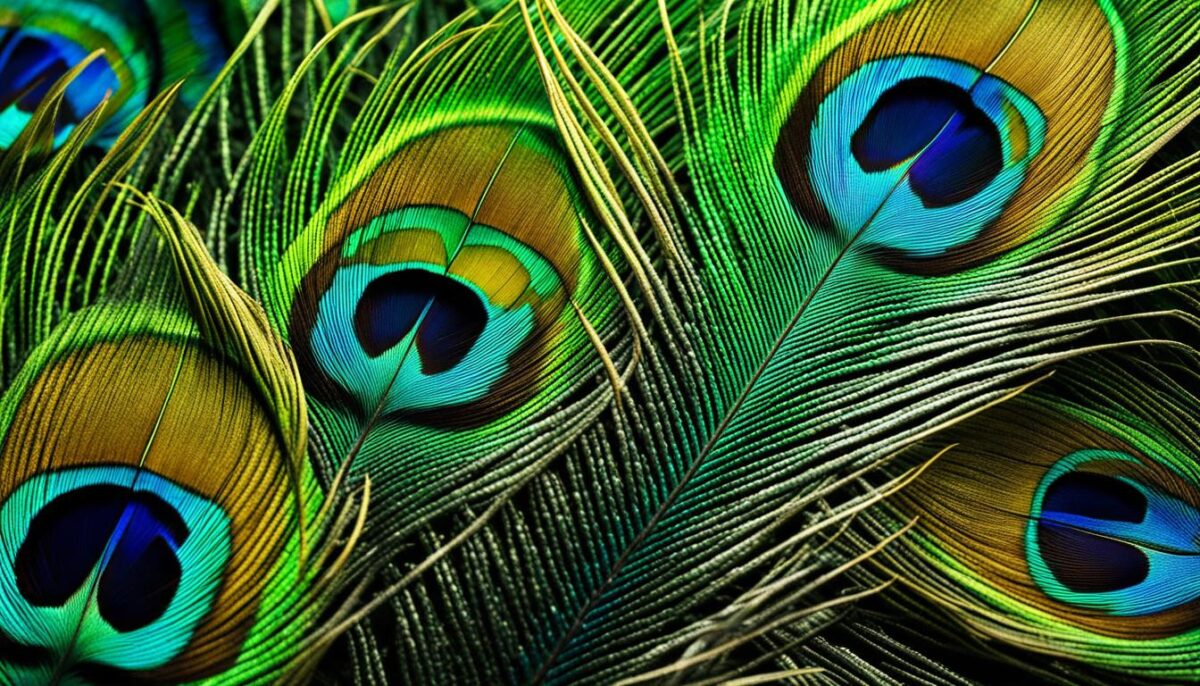
Table: Scientific Studies on Peacock Feather Colors
| Study | Methodology | Key Findings |
|---|---|---|
| Dutt et al. (2015) | Analyzed peacock feather nanostructures using scanning electron microscopy | Discovered intricate arrangements of melanin and keratin contribute to color reflection |
| Prum et al. (2017) | Conducted genetic analysis to identify color-related genes in peacocks | Identified specific gene variations responsible for blue and green feather colors |
| Shawkey et al. (2019) | Used spectrophotometry to measure the reflectance properties of peacock feathers | Determined how different structural arrangements create iridescent colors |
These studies and many others have contributed to our understanding of the fascinating world of peacock feather colors. While there is still much to learn, the scientific study of these colors continues to provide valuable insights into the natural world.
The Importance of Peacock Feather Colors in Courtship
Peacock feather colors play a crucial role in courtship and mate selection. The vibrant and iridescent colors of peacock feathers are believed to attract the attention of peahens during courtship displays. These colorful displays showcase the peacock’s genetic quality and overall fitness, serving as an important signal for potential mates.
One of the most significant aspects of peacock feather colors in courtship is the presence of blue-green eyespots. These eyespots, found on the peacock’s tail feathers, have been shown to have a strong influence on mating success. Studies have revealed that peahens often focus their attention on these eyespots, considering them an attractive trait in peacocks.
“The eyespots on peacock feathers are a remarkable example of sexual selection,” explains Dr. Jane Thompson, a leading expert in avian behavior. “The blue-green hue of these eyespots is particularly captivating to peahens and plays a significant role in mate choice.”
Peacocks are known for their elaborate courtship displays, during which they fan out their magnificent feathers and perform intricate dances. This display not only showcases the vibrant colors of their feathers but also highlights their physical prowess and vitality. The variations in peacock feather colors among different species and individuals further contribute to the overall courtship process, allowing peahens to select the most genetically fit mates.
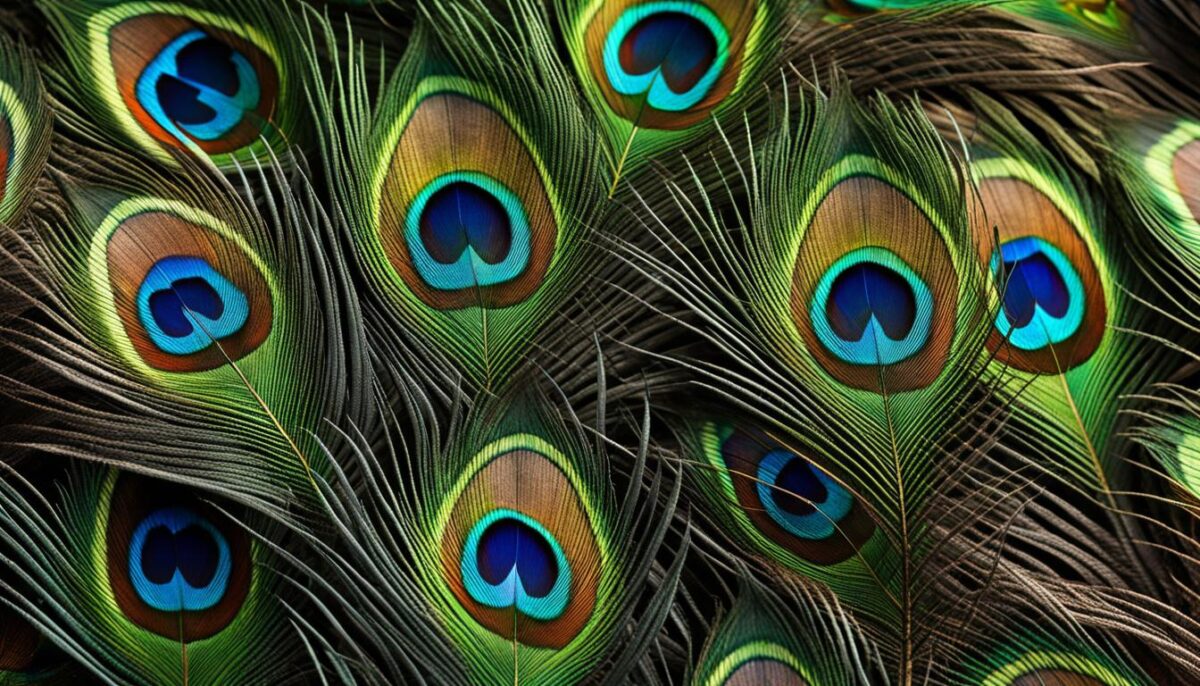
For instance, peacock feathers from certain regions may showcase more vibrant blues, while others may have a greater prevalence of greens or golds. This natural variation adds to the overall diversity and beauty of these magnificent birds, captivating researchers and enthusiasts alike.
Regional Variations in Peacock Feather Colors
The natural variation in peacock feather colors can be observed across different regions where peafowl populations thrive. Here are some notable examples of regional color variations:
| Region | Color Variation |
|---|---|
| India | Brilliant blues and vibrant greens |
| Sri Lanka | Rich golds and warm bronze |
| Myanmar | Iridescent blues and deep emerald greens |
| Indonesia | Shimmering blues and striking turquoise |
Note: The table above provides a simplified representation of regional color variations and is not an exhaustive list.
The distinct color variations in peacock feathers highlight the intricate interplay between genetics and the environment in shaping these stunning displays of nature.
The Cultural Significance of Peacock Feather Colors
The vibrant colors of peacock feathers have captivated cultures across the globe, holding deep cultural significance and symbolism. These feathers have been revered for their beauty and used as symbols of wealth, royalty, and spirituality in various traditions. Peacock feathers have a long history of association with prestige and opulence, often adorning the garments and accessories of kings, queens, and nobility.
In many cultures, peacock feathers are considered sacred and are used in religious ceremonies and rituals. They are believed to bring good luck, protection, and prosperity. The mesmerizing colors of peacock plumage have inspired artists, designers, and architects, influencing the creation of intricate patterns, vibrant textiles, and ornate architectural details. The cultural significance of peacock feather colors reflects the universal appeal and admiration for the stunning colors found in nature.
The peacock is “the bird with a thousand eyes,” symbolizing wisdom, watchfulness, and all-seeing knowledge. Its colorful plumage is a testament to the wonders of nature.
Peacock feather patterns and colors have also inspired fashion trends and interior design. The rich hues and intricate patterns found in peacock plumage have been incorporated into clothing, jewelry, and home decor. The vibrant blues, greens, golds, and bronzes of peacock feathers have become synonymous with luxury and elegance, adding a touch of exotic beauty to any setting.
Table: Cultural Symbolism of Peacock Feather Colors
| Culture | Symbolism |
|---|---|
| Indian | Good luck, immortality, prosperity |
| Greek and Roman | Immortality, protection against evil |
| Chinese | Peace, harmony, beauty |
| Christian | Resurrection, immortality |
| Islamic | Protection against envy, positive energy |
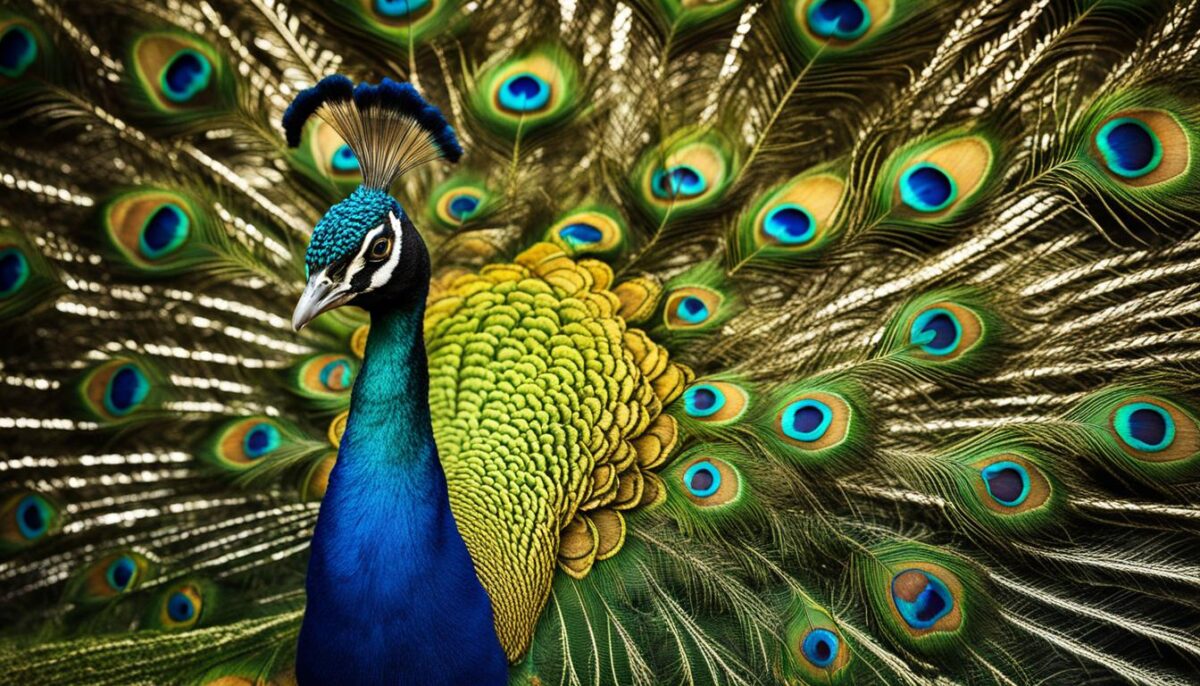
The cultural significance of peacock feather colors is a testament to their timeless allure and enchanting beauty. From ancient mythology to modern-day fashion, these feathers continue to captivate and inspire, showcasing the depth and diversity of human admiration for the wonders of the natural world.
Conclusion
Peacock feathers are a stunning testament to the beauty and diversity of the natural world. These magnificent birds exhibit a breathtaking array of colors, including vibrant blues, greens, golds, and bronzes, within their plumage. The colors of peacock feathers are created by the unique arrangement and structure of pigments, resulting in a mesmerizing display.
These vibrant colors have evolved as part of the peacock’s courtship display, playing a crucial role in attracting potential mates. The iridescent blues, greens, and other hues capture the attention of peahens, signifying good health and genetic quality in peacocks. The variations in color among different peacock species and populations add to the overall diversity and allure of these magnificent creatures.
Scientific research has delved into the physics and biology behind peacock feather colors, uncovering the fascinating mechanisms that produce their brilliant hues. The intricate structures and arrangement of pigments within peacock feathers have the potential for future applications in various fields, from developing new ways to create colors to enhancing computer chip technologies.
Overall, peacock feather colors continue to captivate and inspire us, showcasing the wonders of nature’s palette. The vibrant hues and intricate patterns found in these feathers serve as a reminder of the awe-inspiring beauty that exists in the natural world.
FAQ
What colors do peacocks come in?
Peacocks exhibit a wide range of vibrant colors in their plumage, including shades of blue, green, gold, and bronze.
How are the colors of peacock feathers created?
The colors of peacock feathers are created by the arrangement of pigments and the way light reflects off the feathers’ structures. The color spectrum is a result of the structure of the feather rather than the presence of actual pigment.
What role do eyespots play in peacock feather coloration?
The eyespots on peacock feathers are complex structures with multiple colors, including purple-black, blue-green, and bronze-gold. They are believed to be a major focus of female attention and an attractive trait in peacocks.
How do peacock feather colors vary among different individuals and populations?
Peacock feather colors can vary naturally among different individuals and populations. This variation is influenced by genetics and environmental factors.
How do peacock feather colors influence courtship and mate selection?
The vibrant and iridescent colors of peacock feathers attract the attention of peahens during courtship displays. The variations in color can be an important signal of genetic quality and overall fitness.
What are the potential applications of peacock feather colors?
The unique colors and structures of peacock feathers could have applications beyond their aesthetic appeal. They could potentially be used in data transfer and improve computer chip technologies.
What is the significance of peacock feather colors in cultural traditions?
Peacock feathers have been revered for their beauty and used as symbols of wealth, royalty, and spirituality in various traditions. They are considered sacred and used in religious ceremonies and rituals.
How have scientists studied the colors of peacock feathers?
Scientists have conducted extensive studies using microscopes, cameras, computer models, and light-measuring equipment to analyze the structure and properties of peacock feathers. Mathematical models have been developed to study the effects of different parameters on feather colors.
What is the evolutionary significance of peacock feather colors?
The vibrant colors of peacock feathers have evolved as part of the peacock’s courtship display and play a role in attracting mates. They may also serve as signals of overall health and genetic quality.
How do peacock feather colors vary based on perception?
The perception of peacock feather colors can vary depending on the viewing angle and lighting conditions. Peacocks display their feathers in a way that maximizes the visibility of their colors.
What is the natural variation in peacock feather colors?
Different individuals and populations of peafowl may exhibit unique color variations depending on their geographical location and genetic makeup. This natural variation adds to the overall diversity and beauty of peacocks.
What is the conclusion regarding peacock feather colors?
Peacock feather colors are a marvel of nature, showcasing a breathtaking array of vibrant hues. They play a crucial role in courtship and mate selection, have potential applications beyond aesthetics, and have captivated cultures worldwide for their beauty and symbolism.


